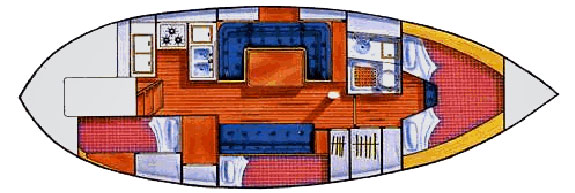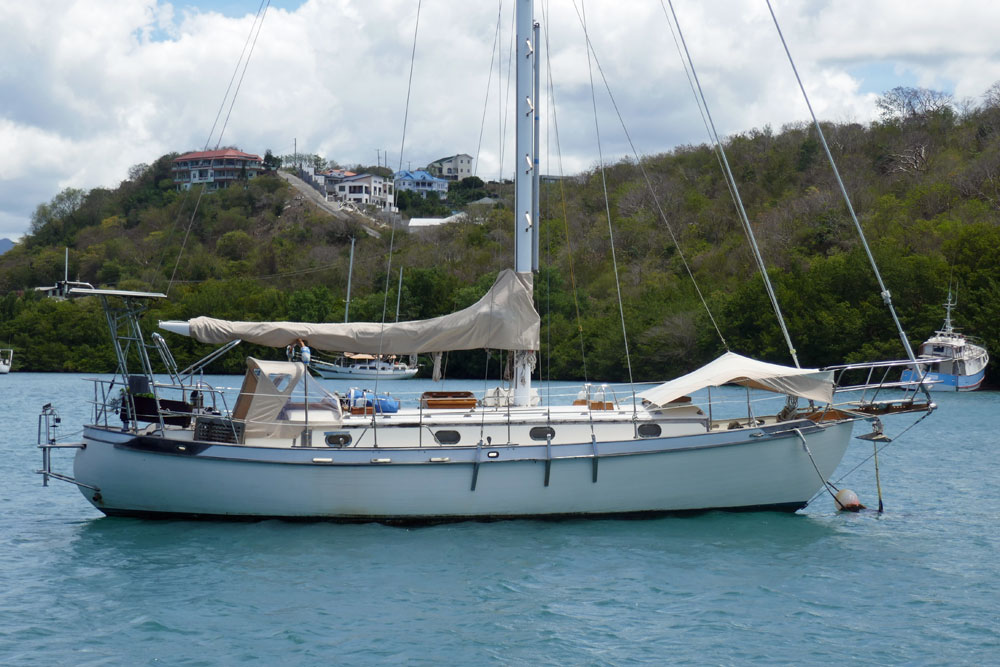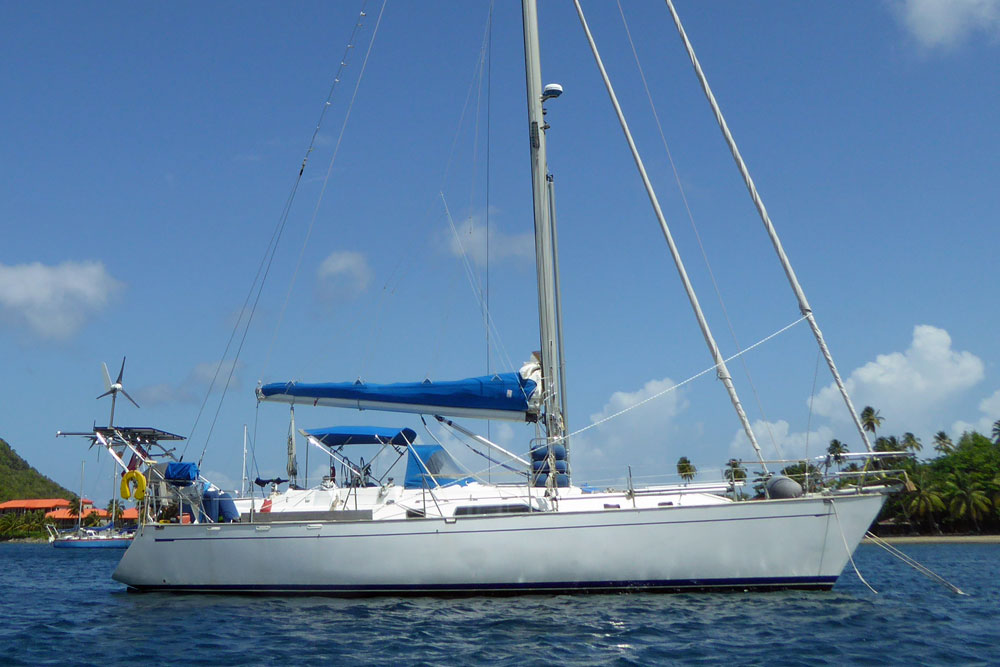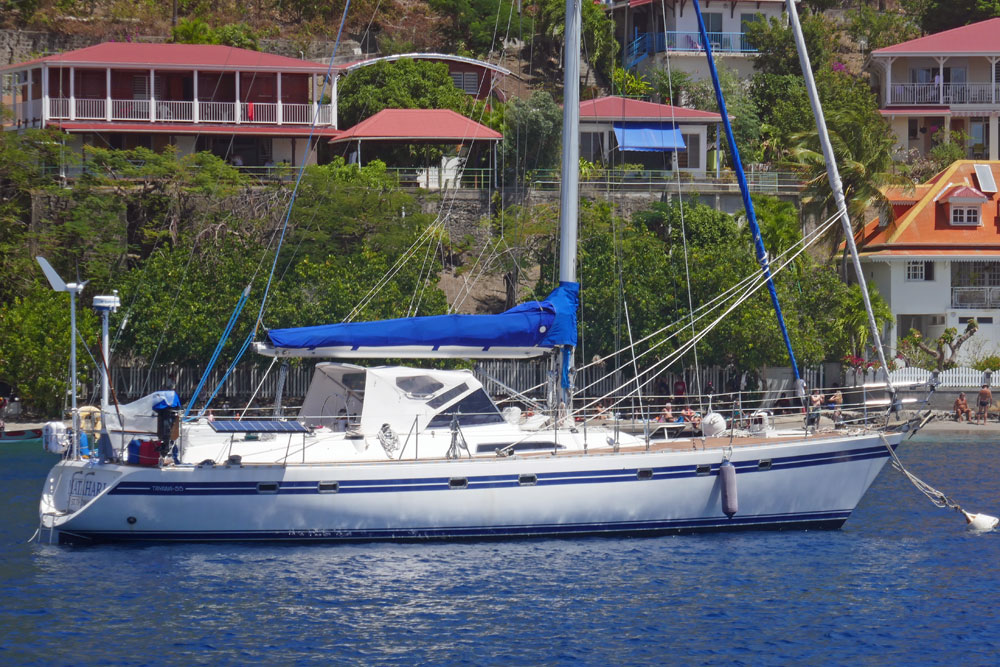- Home
- Cruising Yachts 35' to 40'
- Tayana 37
The Tayana 37 Sailboat
Specs & Key Performance Indicators
The Tayana 37, a long-keeled cutter, was designed by Bob Perry and built in Taiwan by Ta Yang Yacht Building.
Published Specification for the Tayana 37
Underwater Profile: Long Keel
Hull Material: GRP
Length Overall: 36'8" / 11.2m
Waterline Length: 31'0" /9.5m
Beam: 11'6" / 3.5m
Draft: 5'8" / 1.7m
Rig Type: Cutter
Displacement: 22,500lb / 10,206kg
Designer: Bob Perry
Builder: Ta Yang Yacht Building (Taiwan)
Year First Built: 1976
Number Built: 558
Owners Association: Tayana Owners Group
 Tayana 37 Accommodation Layout
Tayana 37 Accommodation LayoutPublished Design Ratios for the Tayana 37
- Sail Area/Displacement Ratio (SA/D) of 17.4: This ratio suggests that the Tayana 37 has a moderate amount of sail area relative to its displacement. Boats with an SA/D ratio in this range are typically balanced in terms of power. They have enough sail to perform well, especially in moderate wind conditions, but they're not overpowered in heavier winds.
- Ballast/Displacement Ratio (B/D) of 35.6%: This ratio indicates a good amount of ballast relative to the boat's total weight. A higher B/D ratio is often associated with better stability, which means the Tayana 37 can handle stronger winds and rough seas more comfortably. It provides a reassuring feeling of safety and steadiness, making it suitable for offshore cruising.
- Displacement/Length Ratio (D/L) of 337: A higher D/L ratio implies that the Tayana 37 is a heavy displacement boat. Heavy displacement boats are known for their sea-kindly motion, making them comfortable over long passages. They may not be the fastest, especially in light winds, but they excel in providing a smooth ride in rough conditions.
- Comfort Ratio of 41.1: This ratio takes into account the displacement and length of the boat to provide a measure of comfort at sea. A higher comfort ratio indicates that the boat will have a more comfortable motion in waves. The Tayana 37, with a comfort ratio of 41.1, is designed with long-distance cruising in mind, ensuring that the crew experiences less fatigue during extended periods at sea.
- Capsize Screening Formula (CSF) of 1.6: The CSF helps determine a boat's likelihood of capsizing. A CSF value below 2.0 is considered good for offshore cruising, indicating that the Tayana 37 is a stable and seaworthy boat, less likely to capsize in heavy seas.
In summary, the Tayana 37 is designed to be a stable, comfortable, and seaworthy cruising sailboat. It's well-suited for long-distance voyages and can handle a variety of sea conditions with ease. While it may not be the fastest boat in light winds, its design prioritizes safety and comfort, making it an excellent choice for offshore sailing adventures.
Design Ratios: Notes of Caution...
- The Sail Area/Displacement Ratio (SA/D): This ratio provides an estimate of the sail power relative to the boat's weight, which can indicate potential speed in various wind conditions. But it doesn't account for the efficiency of the sail plan, the rigging, or the skill of the crew. Real-world performance can vary significantly based on these factors.
- The Ballast/Displacement Ratio (B/D): This ratio gives an idea of the boat's stability and stiffness, which is crucial for handling and safety. But it doesn't consider the distribution of the ballast or the hull shape, both of which can greatly affect stability. A high B/D ratio alone doesn't guarantee a stable boat if the ballast is poorly distributed.
- The Displacement/Length Ratio (D/L): This ratio helps predict the boat's speed potential and its behaviour in different sea conditions. But it doesn't account for the hull design or the boat's overall weight distribution. Two boats with the same D/L ratio can perform very differently if their hull shapes are different.
- The Comfort Ratio (CR): This ratio estimates the boat's motion comfort in a seaway, which is important for long passages. But it doesn't consider the boat's interior layout, which can also affect comfort. Additionally, personal tolerance to motion varies, so a boat that is comfortable for one person might not be for another.
- The Capsize Screening Formula (CSF): This formula assesses the likelihood of a boat capsizing in heavy seas, which is critical for offshore safety. But it doesn't take into account the boat's handling characteristics or the skill of the crew. A boat with a low CSF can still capsize if poorly handled in severe conditions.
General Limitations
- Static Nature: These ratios are static measurements and don't account for dynamic factors like wave action, wind gusts, or crew actions.
- Simplification: They simplify complex interactions into single numbers, which can be misleading. Real-world performance is influenced by a multitude of factors that these ratios can't fully capture.
- Context: The context in which the boat is used (e.g., coastal cruising vs. offshore racing) can greatly affect how these ratios should be interpreted.
In summary, while these ratios provide valuable insights into the theoretical performance characteristics of a sailboat, they should be used as part of a broader assessment that includes practical experience, sea trials, and expert advice.
Other sailboats in the Tayana range include:
Recent Articles
-
Is Marine SSB Still Used?
Apr 15, 25 02:05 PM
You'll find the answer to this and other marine SSB-related questions right here... -
Is An SSB Marine Radio Installation Worth Having on Your Sailboat?
Apr 14, 25 02:31 PM
SSB marine radio is expensive to buy and install, but remains the bluewater sailors' favourite means of long-range communication, and here's why -
Correct VHF Radio Procedure: Your Questions Answered
Apr 14, 25 08:37 AM
Got a question about correct VHF radio procedure? Odds are you'll find your answer here...















